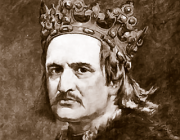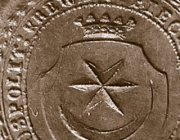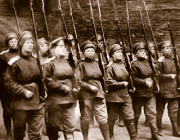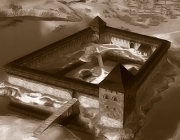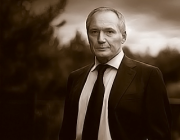Magdeburg Place
Western Europe Democracy
XIV - XVIII
Specific principality of Kreva ceased to exist at the end of the XIV century. Along with the surrounding settlements Kreva was reorganized to one of estates of the Great Duchy of Lithuania. In those days it was called «kings land», «state» or «district».
Monetary income from residents of the town was directed mainly to the royal treasury. Part of the collected funds went to “feeding” the elders (governors and other masters). The elders were the feudal lords, to whom the king (or the Grand Duke) leased the estates for their service. Sometimes such elders rented the land out by themselves. They did it when they were too busy with government service or simply did not want to burden themselves with economic issues.
One of the first elders in Kreva was Andrei Gashtovt. He was mentioned in the documents of 1398 – 1401. Sudimont Dorgevich was registered as a head of Kreva in the act of the Grodno-Trotsky Union 1432. In 1468 Kreva was ruled by Vasili Zenovich. The documents of 1488 – 1491 give us the information about the Stanka Dukurn, elder of Kreva.
Under King Alexander, late XV and early XVI centuries, Stanislav Narbutovich and Duke Sestrenets were in charge in Kreva. From 1511 to 1522 the headman in Kreva was Peter Glebovich. In 1532, the headman is Andrei Epimahovich. A year later it was Nikodim Tekhanovski (Tekhanovetski), right hand of the Duke of Lithuania. He is known for having travelled to Moscow in July 1536 to conclude peace in the Russian-Lithuanian war. From 1533 to 1538, Kreva was ruled by Mikhailo Sviniusski. From 1540 to 1555 – Nikolai Narbut.
Was there a Russian Duke in Kreva?
In 1566 the Russian Duke Andrei Kurbski took the eldership in Kreva. He was hiding in the Grand Duchy of Lithuania from the despotism of Ivan the Horrible. Actually he ruled Kreva not by himself, but his deputy was in charge. The Duke lived in Volynshchyna, where he also owned lands he received from King Sigismund Augustus. Krebski didn’t owe Kreva for a long time – the Lublin Unia of 1569 was signed by the other person – Lukash Svirski.

Russian Duke Andrei Kurbski
Andrei Kurbski’s coat of arms
From 1579 to 1633 the Kreva’s eldership was in hands of the Volminskis. The next owner was Kryštof Khodkiewicz, the Castilian of Vilna and the warlord. He was in charge of Kreva since 1636. Under his rule the church of Kreva was rebuilding. The appearance of hospital and school in Kreva couldn’t happen without his participation.
After Khodkevich the head of Kreva was Jan Narashevich for some time. In 1653, he handed his power over to Kazimir Franzkevich, who handed it over to Karol Marson in 1673. For almost the entire XVIII century Kreva was in disposal of Slizenj clan. First the headman here was the scribe of Oshmiany and marshal of the Lithuanian tribunal Jan Slizenj. In 1702, with the permission of King Augustus II, the ownership of Krevа passed to his son Michal.
In 1767 King Stanislaw August granted the eldership of Kreva to the Land Judge of Slonim Stefan Slizen and his wife Sofia. In 1775 Kreva received by Yazep Vazhinski, the Land Judge of Oshmiany. However, for 2,000 złoty he returns it to Slizenjs clan in 1787, this time to Rafal and Tekla. And two years later Kreva came under the rule of Sofia Slizenj, the Land Judge of Slonim widow.
The territory of Kreva eldership changed over the years. At first it was quite a large district. Till the time of King Alexander, for example, its territory included “Spiagliany area” (after – Spiagla, Spiaglitsa, and nowadays – Svetilovichi village in the Vishnevsky village council of the Smorgon district). Alexander gave it to the Duke Mikhail Mstislavsky, and this land was forever withdrawn from Kreva district.
When did the democracy of Kreva end?
There is information that Kreva received the Magdeburg law on 7th of April 1559. Together with the right to self-government, the town got permission to organize fairs. The rules of trade were regulated by the document of 1601. It appeared after an audit in eldership of Kreva.

The symbols of self-government, except for the royal privilege, were the town coat of arms, the seal and the town hall building. The coat of arms was presented by Leliva – a shield with a crescent and a six-pointed star on it. The same sign was depicted on the town seal. It had an inscription: “Seal of the place of Rzeczpospolita Kreva”.
The Magistrate, a local government body, was headed by voight. He was appointed by the Grand Duke or the elder in the name of the ruler. Voight was supposed to represent the interests of both the authorities and local residents. This order existed until 1679. And after King Ian III decided that the voight should be chosen by the local residents. The person who held this post had the right to hold the joint court. His deputy helped him by this. So at the end of the XVII century the democratic conditions for self-government were established in Kreva.
It seemed that this district was developing. The system of interaction between people and authority here was similar to traditions of Western Europe. But the circumstances didn’t favor to Kreva. At the end of the 18th century the lands of the GDL and the Commonwealth became a part of the Russian Empire. Many settlements lost the status and rights of towns, and Kreva was one of them.


